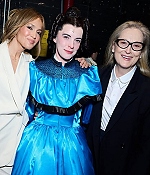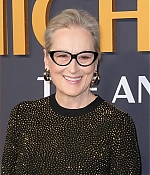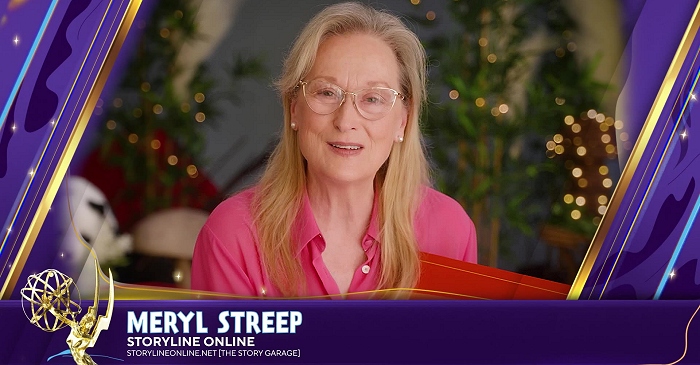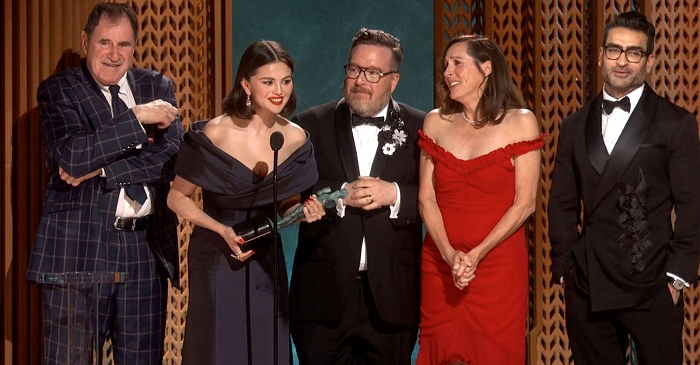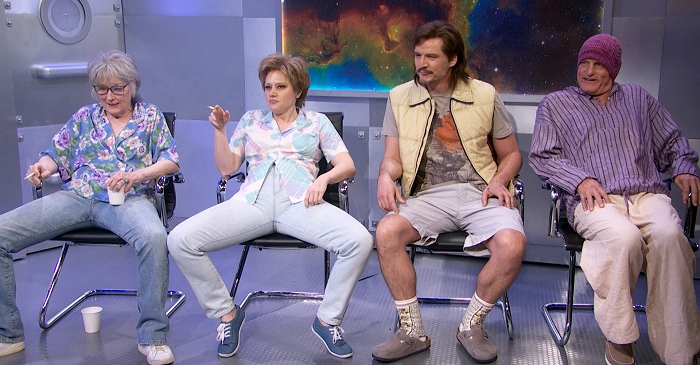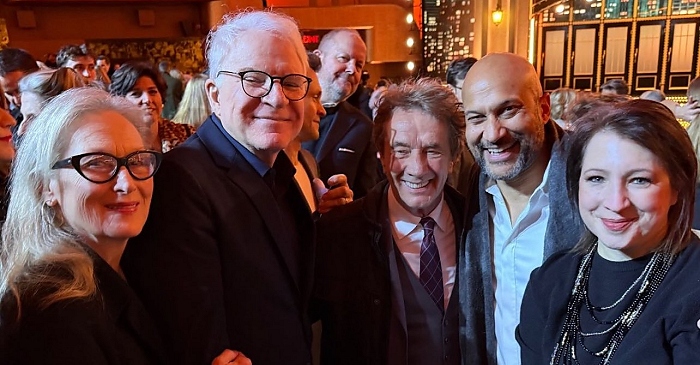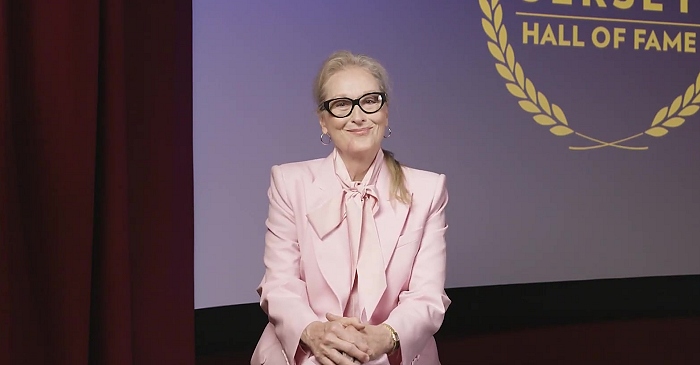|
Simply Streep is your premiere source on Meryl Streep's work on film, television and in the theatre - a career that has won her the praise to be one of the world's greatest working actresses. Created in 1999, we have built an extensive collection to discover Miss Streep's body of work through articles, photos and videos. Enjoy your stay.
|
Celebrating
25 years
of SimplyStreep
|
|
That Unmistakeable Streepness
The New York Times ·
February 18, 2010
· Written by A.O. Scott
|
From the moment it was announced on Feb. 2, Meryl Streep’s 16th Oscar nomination – best performance by an actress in a leading role for “Julie & Julia,” in case your attention has been otherwise occupied – seemed both richly merited and a bit redundant. Of course she would! How could she not? It is barely an exaggeration to say that you can’t have an awards season without Ms. Streep, who has been enmeshed in roughly half of them since 1979, when she was nominated for best supporting actress in “The Deer Hunter.” She won that category the next year, for “Kramer vs. Kramer,” and was nominated in it once again, in 2003, for “Adaptation.” Those three supporting nods are filigree on top of the 13 nominations for best actress, which she won on her second try, in 1983, for “Sophie’s Choice.”
More than a quarter-century has passed since then, which may mean that Ms. Streep is overdue for a third statuette. Since her last one Oscars have gone to Gwyneth Paltrow, Hilary Swank (twice) and many other more- and less-deserving younger performers, while Ms. Streep, 60, has been a constant, patient and routinely passed-over Oscar-night presence. Has she received too much recognition or too little? Trying to quantify an answer is really just trivial showbiz math, pseudoscientific data marshaled in support of a conclusion that is already axiomatic: Meryl Streep is the best screen actress in the world. I’m not inclined to disagree. A case could conceivably be made for Isabelle Huppert or Juliette Binoche or some other French actress, but everybody knows France is different. Actresses are regarded there as something between natural resources and national treasures, whereas here they tend to be idols, commodities or fetish objects. And in some respects Ms. Streep’s career resembles that of some of her French counterparts, like Ms. Huppert and even Catherine Deneuve, who move nimbly between large and small films, between comic and dramatic roles, and who have been permitted to age not only gracefully, but also grandly and sensually.
But Ms. Streep is also, unmistakably, a movie star. As such, she has been something of a late bloomer. An eminent and admired actress for three decades, she has emerged in the last few years, perhaps surprisingly, as a box office draw. “The Devil Wears Prada,” “Mamma Mia!,” “Julie & Julia” and “It’s Complicated” were all hits, and it is fair to say that her participation in them was not a correlative of their success, but a cause. Esteemed for as long as most moviegoers can remember, she now finds herself beloved. Looking back over her work – from the “Holocaust” mini-series and “The Deer Hunter,” through “Sophie’s Choice” and “Silkwood” and “A Cry in the Dark” and then “Heartburn” and “She-Devil” to those last four – you note a progressive lightening of tone, though not a relaxation of technique. The movies that established Ms. Streep as a formidable, even intimidating on-screen force were marked by heavy themes and deep, dark dramatic moods: Vietnam, divorce, the Holocaust, missing children, nuclear anxiety. Her filmography in the 1980s is an anthology of earnest, serious cinematic ambition, frequently buttressed by literary prestige (faithful adaptations of John Fowles, William Styron and Isak Dinesen) and steered by blue-chip directors of the Hollywood mainstream of the time, including Alan J. Pakula, Mike Nichols and Sidney Pollack.
The reputation that Ms. Streep earned for her work in those films retains more luster than most of the movies themselves. Sandwiched between the endlessly mythologized Golden Age of ’70s New Hollywood and the now almost equally sentimentalized decade of the American Indies, the ’80s are comparatively bereft of nostalgic movie-fan affection or revisionist critical love. And yet the respectable films of that era may represent the last gasp of a noble middlebrow ideal. They were ambitious, unapologetically commercial projects intended for the entertainment and edification of grown-up audiences, neither self-consciously provocative nor timidly inoffensive. Some of us grew up on movies like “Sophie’s Choice” and “Out of Africa,” and our fondness outlasts the sense that we eventually outgrew them. Nowadays “Kramer vs. Kramer” and “A Cry in the Dark” would be scruffy little Sundance movies. “Out of Africa” would be in French. “Silkwood” would be “The Blind Side.” Ms. Streep – grave, scrupulously attentive to the nuances of performance, imbuing every gesture with the values of craftsmanship and respect for quality – was not only the star of so many of these ’80s Oscar movies, but also the most recognizable embodiment of their aesthetic. Which is not to say that she was in any way a fixed or predictable presence. On the contrary, her hallmark in those years – the trait that elicited, from one film to the next, almost ritualistic expressions of awe – was her chameleonism. She mastered the accents of an astonishing array of regions and countries: western Pennsylvania in “The Deer Hunter,” Oklahoma in “Silkwood,” Poland in “Sophie’s Choice,” Australia in “A Cry in the Dark,” Kenya by way of Denmark in “Out of Africa.”
And her temperament and physical appearance seemed as mutable as her voice. Ms. Streep, in her early, major phase was variously enigmatic, severe, wounded, butch, sylphlike and aristocratic, changing souls as easily as she changed hair colors and styles. And there were a remarkable range of those as well: dark pageboy, brown mullet, reddish bob – all heroic suppressions, in the cause of art, of her natural blondness. But to say that she disappeared into these roles is not quite accurate. Rather, she used the particularities of these disparate characters to reveal some essential facet of herself, an ineffable but unmistakable Streepness. In one of the few skeptical assessments of this elusive quality, Pauline Kael, reviewing “Sophie’s Choice,” suggested that Ms. Streep was too controlling, too calculated, to create characters of full and spontaneous humanity. “It could be that in her zeal to be an honest actress,” Ms. Kael speculated, “she allows nothing to escape her conception of a performance.”
Often, though, this thoroughness was a virtue, bringing to vaguely conceived, unevenly executed films (like “Sophie’s Choice,” and also “Out of Africa”) a discipline and clarity they otherwise would have lacked. Not a greater dimension of realism, exactly – Ms. Kael was on to something in intuiting a crucial element of premeditation in Ms. Streep’s performance – but a precision that made the characters interesting even as it called attention to the virtuosity of the actress portraying them. Given the bias that reflexively elevates heavy over light when it comes to screen acting, it may seem perverse to argue that the much-lauded dramatic roles of the ’80s are preparation for the comic flowering that began at the end of that decade with movies like “She-Devil” and “Postcards From the Edge.” Ms. Streep hardly abandoned drama, or the bravura explorations of challenging accents and hairstyles. (See her syllable-perfect turn as the bored, expatriate Italian farmwife in the perpetually underrated “Bridges of Madison County.”) But she began to reveal a playful, mischievous side, an anarchic impulse that, joined to her formidable timing and technique, has blossomed in the past 10 years or so.
You can hardly say, looking at “The Devil Wears Prada” or “Julie & Julia,” that her gift for deep mimicry has diminished. Or that, in “Doubt,” her commitment to dramatic intensity has waned. In her portrayal of Julia Child, the posture, the voice, the bubbly blend of ruthless drive and irrepressible joie de vivre are almost uncanny. But these days impersonation is the province of every aspiring biopic star. Ms. Streep’s Julia Child is never anything other than a performance, a fusion of two strong personalities rather than the absorption by one into another. You never forget that you are watching Meryl Streep inhabiting a version of Julia Child, and instead of distracting you from the truth of Julia, this awareness is what enables you to understand her. It is our familiarity with Ms. Streep that makes her exploration of a more private Julia Child both credible and exhilarating. Similarly in her frequent forays into the world of cinematic statecraft, she can be an entirely convincing senator or cabinet secretary while still being, in every syllable and flourish, Meryl Streep. She is also, evidently, enjoying herself, and the delight in watching Ms. Streep these days – whether as a spacey folk singer in “A Prairie Home Companion,” a romantically confused divorcee in “It’s Complicated,” or even that steely Irish-American street cop of a nun in “Doubt” – comes partly from a sense of shared pleasure. All of the old discipline is there, but she seems to be having more fun.
And it is fun to watch her now, in her late, authentic prime, in part because we have known her for so long. We know she can do anything – play Ethel Rosenberg, a Mormon mother and an Orthodox rabbi in “Angels in America,” voice a fox married to George Clooney in “Fantastic Mr. Fox,” a 36-year-old Julia Child and a sensuous Santa Barbara bakery owner in “It’s Complicated” – which means that she does not have anything left to prove. It can be argued that, having staked out an enormous range early in her career – embodying women of various classes, periods, nationalities and personalities – Ms. Streep has settled into a narrower constellation. Who has she been, lately? A New Yorker writer in “Adaptation,” a magazine editor in “The Devil Wears Prada,” a radio performer in “A Prairie Home Companion” and a cookbook author in “Julie &d Julia,” directed by Nora Ephron, a noted food writer before she was a filmmaker, whom Ms. Streep had already played, more or less, in “Heartburn.”
These characters all inhabit a cultural universe that is easy to caricature, even to ridicule as liberal and elitist in these culturally suspicious, ideologically contentious times. (Even Sister Aloysius, in “Doubt,” lives in that cosmos, though as a designated monster rather than a paragon.) But real movie stars know no such limitations of context. They belong to everyone. The genius of Julia Child was to demystify her art, to insist that anyone could cook the way she did, and Ms. Streep does something similar. Not that any of us could act with such consummate skill, resourcefulness and dignity. We can’t be Meryl Streep. And yet, whoever she is pretending to be at the moment, however she is, with sublime calculation and faultless craft, being herself, we can’t help but feel that she is one of us.

